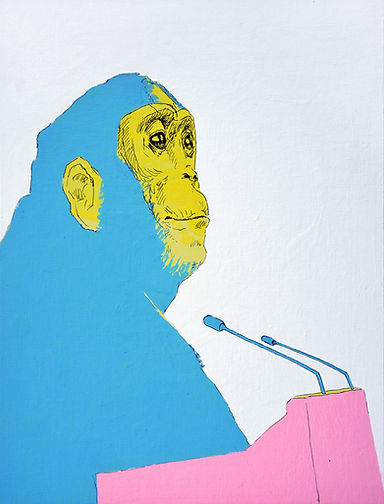
artist
statement
The art of Carlos Echeverria Kossak is a journey through a universe of carefully crafted worlds – many inhabited by iconic characters – places where opposites coexist, where nature and architecture interact, and where the familiar sits alongside the disquieting. Kossak's canvases are windows into complex narratives that leap through dimensions of time and space to explore themes of authority, hierarchy, and the complexities inherent in these power dynamics. His pieces are rich with ambiguity, layered meanings, and dialogues that weave references to classical works with allusions to the Zeitgeist.
The work of Carlos Kossak asks you to do more than passively observe – you are playfully invited to participate, react, and question your own perspectives, opinions, and concepts of identity. You are lightly drawn into profound conversations that may slowly reveal the absurdities inherent in our societal structures.
Through the lens of painting, Carlos Echeverria Kossak challenges you to think deeply about space, time, nature, and power and your own role within these constructs.
BIOgraphy
Born in 1981 in Poznań, Poland, to an Ecuadorian father and a Polish mother, Carlos Echeverria Kossak showed an early aptitude for art, specifically drawing and painting. When he was six months old, Carlos and his family moved to Quito, Ecuador, returning to Poland for a few years when Carlos was four, before settling permanently in Ecuador when he was seven. His dual nationality and the contrasting experiences of living between the Ecuadorian Andes and Europe have given him a unique perspective that has informed his creative work.
After spending two years studying architecture at the University of San Francisco in Quito, Carlos transitioned to the field he was most passionate about – painting. In 2001, he traveled back to Poland to study at the Academy of Fine Arts in Krakow, where he was mentored by Professor Leszek Misiak. Architecture, however, has remained a prominent feature in his painting, heavily influencing his references to space, structure, and form.
In 2006, Carlos received the Socrates-Erasmus scholarship to study in Spain at the University of Castilla-La Mancha's Faculty of Fine Arts. Two years later, he was awarded a scholarship by Poland's Ministry of Culture and National Heritage, which supported his Ph.D. research on "The Mask and Shamanism in Painting" at his Krakow alma mater.
Carlos moved back to Quito in 2011, where he now serves as a full-time professor at the University of San Francisco. From 2012 to 2015, he also coordinated the university's Contemporary Arts program. His artistic career is marked by over 10 solo exhibitions in both Ecuador and abroad.


SOLO EXHIBITIONS
2023
“Carlos E Kossak Obra pictórica” Centro Cultural PUCE. Quito, Ecuador.
2021
“Impacto mínimo” +ARTE galería. Quito, Ecuador.
2019
“Complot” Galería Nómada y Galería Violenta. Quito, Ecuador.
2017
“Dinámicas de Poder” +ARTE galería. Quito, Ecuador.
2014
“Vértice” Ileana Viteri Galería de Arte. Quito, Ecuador.
2013
“Liquidez” Sala Proceso CCE. Cuenca, Ecuador.
2013 “Narrativas Habitables” Espacio Arte Actual FLACSO. Quito, Ecuador.
2011
“Máscara y chamanismo en la pintura” Galería de pintura de la Academia de Bellas Artes en Cracovia. Defensa de la tesis Phd. en Bellas Artes. Polonia.
2010
“Displaced” Centro Universitario de Idiomas de Shaoxing, China.
2009
“Rysunek”. Galería Camelot & Galería de la Fundación Imago Mundi. Cracovia, Polonia.
2007
“Despota” Camera Cafe Club. Cracovia, Polonia.
2007
“La homogenización de la cultura” Defensa de la tesis MFA. en pintura. Academia de Bellas Artes de Cracovia, Polonia.
2005
"Ciclo Político” Festival Spondylus, Fundación Humanizarte. Quito, Ecuador.
GROUP EXHIBITIONS
2021: Benaventura
2021: Q galeria
2019: “Krakowski Salon Sztuki 2019” Pałac Sztuki. Cracovia, Polonia.
2017 “Leszek Misiak i Uczniowie” NCK, Bunkier Sztuki i Pałac Sktuki. Cracovia, Polonia.
2016 “La Muerte”. Espacio Arte Actual FLACSO. Curaduría: Marcelo Aguirre. Quito, Ecuador.
2015 “Contornos” Centro de Arte Contemporáneo CAC. Curaduría: Édu Carrera R. Quito, Ecuador.
2015 “La muerte” Espacio Arte Actual FLACSO. En el marco de “Espiritualidades” de la Fundación Museos de Quito, Ecuador.
2015 “Espero al borde” Artholic galería. Curaduría: Édu Carrera R. Quito, Ecuador.
2014 “Estadíos ” DPM galería. Guayaquil, Ecuador
2010 “Intuición” Cellar Gallery. Cracovia, Polonia.
2009 Exposición colectiva del taller del prof. Leszek Misiak. Consulado Alemán en Cracovia, Polonia.
2009 “Doktoranci” Galería PWST. Cracovia, Polonia.
2008 “Fetiche” Galería Gologórski. Cracovia, Polonia.
2007 La Vida Gallery, Polish American Cultural Center. Detroit, USA.
2004 “Grey Zone” Centro de Arte Polaco. Budapest, Hungría.
2004 “SFX - prolog Proszków” Proszków, Polonia.
ProJECTS
2015 Proyecto individual “Intervenciones espaciales” Project Room Arte Actual FLACSO. Quito, Ecuador.
2014 Diálogo con las obras de la Colección Alberto Mena Caamaño. “Mirada de artista” Centro Cultural Metropolitano CCM. Curaduría: Pablo Barriga y Mónica Vorbeck. Quito, Ecuador.
2011 Exposición colectiva y video documental “Expedition Art Festival”(Amazonas, Ecuador) en colaboracion con el grupo Strupek y Art Boom Festival:
Kino Lab; Centro de Arte Contemporáneo Zamek Ujazdowski. Varsovia, Polonia; Galerie Senn. Viena, Austria; Espacio Arte Actual FLACSO
2011 “La escala prevalece”. Curaduría: Cristian Parreño. Quito, Ecuador.
2010 “Wymiary Wolności” Proyecto Internacional de talleres interdisciplinarios dirigidos por el prof. Zbigniew Bajek: Proyecto 1. Ex-carcel. Łęczyca, Polonia; Proyecto 2. Central eléctrica. Radom, Polonia; Documentación expuesta en Elektrownia Mazowieckie Centro de Arte Contemporáneo. Radom, Polonia; Galería Malarstwa Academia de Bellas Artes en Cracovia. Polonia; Museo del Castillo de Łęczyca. Polonia.
2009 “Sacrum Profanum”: Centro de Juan Pablo II. Cracovia, Polonia; Galería de facto. Bielsko-Biała, Polonia; Galería Kropka. Czeski Cieszyn, República Checa.
2008 “Kwadrat Magiczny”: Galería Pryzmat ZPAP. Cracovia, Polonia; Centro de Arte Contemporáneo “Solvay” de Cracovia, Polonia; Galeria BWA, Centro de Exposiciones Artísticas. Tarnów, Polonia; Galería Urbana de Arte en Częstochowa, Polonia; Małopolskie BWA, Centro de Exposiciones Artísticas en Nowy Sącz, Polonia.
2007 Proyecto HUTA. Galería virtual 3D. Dirigido por Jacek Doroszenko y Marcin Sipiora. Película interactiva para el 5to Festival Internacional de Artes Visuales. Szczecin, Polonia.
2006 Proyecto interdisciplinario “Parásito Arquitectónico” dirigido por Shahram Entekhabi. Bunkier Sztuki. Cracovia, Polonia.